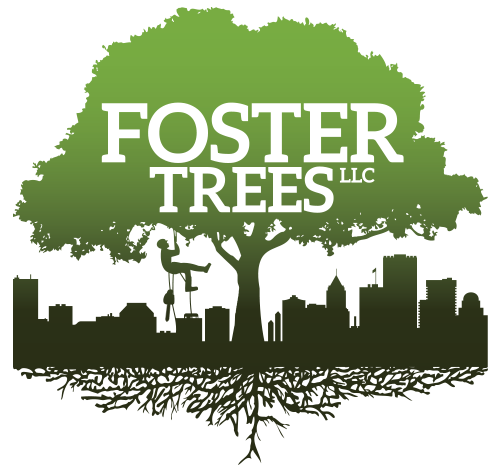Thinking ahead about change
As we inch just past the winter solstice and the light begins to return, there’s a little bit more time to spend inside and reflect on the full and busy year just past us and all the potential for the year ahead. While every year we at Foster Trees spend countless hours caring for trees, much of our tree work looks similar each day (pruning, tree removal, stump grinding).
This fall, we got to support a project that gave us the opportunity to look at trees a little bit differently. We were contacted by Clean Water Services (CWS) to help them assess trees in the riparian zones that they manage, to look for trees that could potentially become hazardous if infested with a pest recently discovered here in Oregon, the Emerald Ash Borer (Agrilus planipennis).
What is Emerald Ash Borer?
Since its presence was discovered in the United States, Emerald Ash Borer (EAB) has killed tens of millions of ash trees across the country. Originating in the temperate climates of northeast Asia (China, Mongolia, Russia, Japan and Korea), the beetle was first identified in the US in northern Michigan in 2002 [1]. Because ash trees in the US didn’t evolve in relationship to this wood-boring beetle, our native (and ornamental) ash tree species don’t have the kind of resistance that trees in its natural habitat show [2]. EAB larvae damage ash trees by tunnelling under the bark and cutting off the xylem from the root system, interrupting the tree’s vascular system and preventing the transport of water and nutrients for the tree to photosynthesize. The beetle has spread quickly across the country, and in June 2022 was detected in Forest Grove [3].
Land managers in the West are now looking to lessons from the Midwest to plan and prepare for what is anticipated to be significant damage to the many ash trees here in the Pacific Northwest. Of particular concern is our native ash tree, Oregon Ash (Fraxnius latifolia). Common in riparian zones in the Northwest, Oregon Ash prefers more soggy and flooded soils [4]. The only native ash tree in the Northwest, this tree plays an important role in mitigating temperatures of streams and wetlands by providing significant shade, in addition the food and habitat value for native birds and insects [5].
Who is CWS and why do they care about trees?
Clean Water Services is a water resources management utility that aims to protect public health while enhancing the natural environment. “In conjunction with 12 partner cities, we provide sewer and Surface Water Management (SWM) to over 600,000 people in the urban areas of the Tualatin River Watershed (PDF), which closely follows the urban growth boundary.[6]” The organization’s focus on protecting the river and watershed while also managing water resources for human health and safety has resulted in significant improvements in the health of the Tualatin River ecosystem in the last 50 years. A critical aspect of watershed health is maintaining cool temperatures in the river – temperatures are critical for fish and insect populations to thrive. CWS manages over 5,000 acres in the watershed surrounding the river and local streams to maintain the riparian canopy and support healthy temperatures in the river and tributaries.
Data gives us options for mitigation
Foster Trees collaborated with numerous other partners to collect data on ash trees in areas managed by Clean Water services. Many of these areas are maintained as recreation spaces or are immediately adjacent to residential properties and spaces that are frequently used. Of primary concern to land managers is the potential for these ash trees to eventually pose a safety risk to people once EAB carves its anticipated path through the area.
We supported this research effort by helping inventory trees on a number of these properties. Data collected included a modified version of a risk assessment. Typically, a risk assessment asks “how hazardous is this tree currently?” In this case, the question asked was “how hazardous will this tree be once it’s dead from an EAB infestation?” This kind of forward planning gathers data on which trees to watch for, and will allow land managers to make proactive decisions about trees that could be mitigated in advance of a hazardous condition. Because trees that die from EAB can be hazardous to climb and remove after their death, proactive decisions about tree removal or mitigation can assist in safe, cost-effective management of resources. In addition, it can help land managers understand the immediate scale of work facing an agency in the coming years. While we didn’t inventory every ash on each property, understanding which trees will likely be most concerning can help land managers work with current budgets to make management choices, rather than being inundated with a wave of needs that budgets can’t meet.
Presence of the Emerald Ash Borer is difficult to detect, and while we focused our work on properties near the first identification of the beetle last year, the current spread of the insect appears to be limited. A current quarantine is in effect for Washington County to prevent the movement of any ash wood or material, working to reduce the opportunity that the insect will spread rapidly to other parts of the Portland Metro area. As we watch and wait to see what the impacts of this new pest will be on our region, it’s imperative that we all act responsibly. Don’t move firewood! Buy it where you burn it! Even in areas that are outside the quarantine, it’s important that wood stay local. As arborists, we dispose of wood material through resources like ChipDrop that allow us to pass wood chips and logs to neighbors in the area where trees were removed. Limiting the transport of these wood products helps to reduce the spread of pests like EAB.
References:
[1] https://www.aphis.usda.gov/aphis/maps/plant-health/eab-storymap
[2] https://nph.onlinelibrary.wiley.com/doi/pdfdirect/10.1111/nph.13604
[4] https://owic.oregonstate.edu/oregon-ash-fraxinus-latifolia
[5] https://backyardhabitats.org/2023/08/native-plant-highlight-oregon-ash/
Back to News >>


